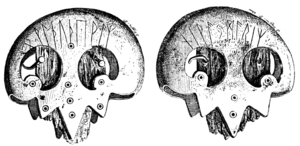Thorsberg chape
The Thorsberg chape[1] (a bronze piece belonging to a scabbard) is an archeological find from the Thorsberg moor, Germany, that appears to have been deposited as a votive offering.[2] It bears an Elder Futhark runic inscription, one of the earliest known, dating to roughly 200 CE.

The artifact has been localized on archeological grounds to the region between the Rhine and the Elbe.[2][3][4]
The inscription reads:
- owlþuþewaz / niwaje͡mariz[2]
- ᛟᚹᛚᚦᚢᚦᛖᚹᚨᛉ / ᚾᛁᚹᚨᛃᛗᚨᚱᛁᛉ
The first element owlþu, for wolþu-, means "glory," "glorious one," cf. Old Norse Ullr, Old English wuldor. The second element, -þewaz, means "slave, servant." The whole compound is a personal name or title, "servant of the glorious one" or "servant/priest of Ullr." On the reverse, ni- is the negative particle, waje- corresponds to "woe, ill" (Old Norse vei), and the final element is -mariz "famous" (Old English mǣre). (The "e" and "m" are written together, as a bind-rune, an unusual early example but probably not linguistically significant.[5]) The second word thus translates to "not ill-famous," i.e., "famous, renowned" or "not of ill fame, not dishonored." Similar double negatives are found on other runic inscriptions.[2] The translation of the inscription can thus be either "Wolthuthewaz is well-renowned," or "the servant of Ullr, the renowned." If the first part refers to the god Ullr, it is the only reference to that god from south of Denmark, and also, if a personal name, the only German example of a person named for a specific Germanic god.[4]
Another reading, avoiding the emendation of the first element, reads the first letter ideographically, "Odal," resulting in o[þalan] w[u]lþuþewaz / niwajmariz "inherited property of Wulthuthewaz, the renowned." However, the owner's name is not in the possessive case as would be expected with such a usage; moreover, the rune Fehu, signifying simply "property," would be more apposite; "odal" denoted specifically real estate.[6]
It is possible that the inscription is poetic; it can be read as an alliterative long-line.[7]
See also
- Weapons sacrifice
Notes
- The inscription has been given the Rundata (Scandinavian Runic-text Data Base) inventory designation DR 7.
- Tineke Looijenga, Texts & Contexts of the Oldest Runic Inscriptions, Leyden/Boston: Brill, 2003, ISBN 90-04-12396-2, p. 259.
- Hans Frede Nielsen, "The Dialectal Provenance of the Gallehus Inscription," in Von Thorsberg nach Schleswig: Sprache und Schriftlichkeit eines Grenzgebietes im Wandel eines Jahrtausends: internationales Kolloquium im Wikinger Museum Haithabu vom 29. September–3. Oktober 1994, ed. Klaus Düwel, Edith Marold, and Christiane Zimmermann with Lars E. Worgull, Reallexikon der germanischen Altertumskunde Ergänzungsband 25, Berlin: De Gruyter, 2000, ISBN 3-11-016978-9, pp. 25-36, p. 31.
- Henrik Williams, "From Meldorf to Haithabu: Some Early Personal Names from Schleswig-Holstein," Von Thorsberg nach Schleswig pp. 149-66, p. 157.
- Mindy MacLeod, Bind-Runes: An Investigation of Ligatures in Runic Epigraphy, Uppsala: Institutionen för nordiska sprak, Uppsala Universitet, 2002, ISBN 91-506-1534-3, p. 51, note 17.
- Williams, p. 156.
- Tonya Kim Dewey, Versatility in Versification: Multidisciplinary Approaches to Metrics, Berkeley Insights in Linguistics and Semiotics 74, New York: Lang, 2009, ISBN 978-1-4331-0578-4, p. 7.